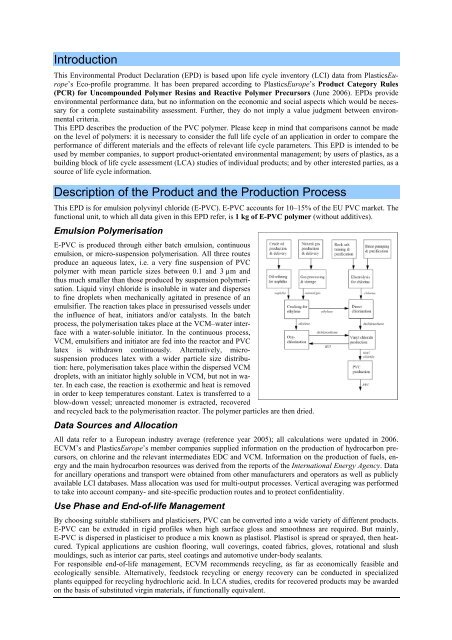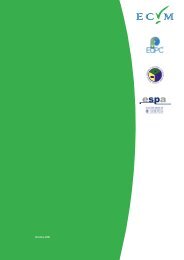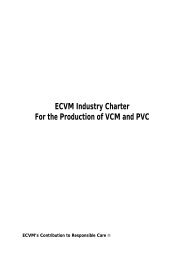EPD E-PVC Final Draft 2007-10-26 - PVC Info
EPD E-PVC Final Draft 2007-10-26 - PVC Info
EPD E-PVC Final Draft 2007-10-26 - PVC Info
Create successful ePaper yourself
Turn your PDF publications into a flip-book with our unique Google optimized e-Paper software.
Introduction<br />
This Environmental Product Declaration (<strong>EPD</strong>) is based upon life cycle inventory (LCI) data from PlasticsEurope’s<br />
Eco-profile programme. It has been prepared according to PlasticsEurope’s Product Category Rules<br />
(PCR) for Uncompounded Polymer Resins and Reactive Polymer Precursors (June 2006). <strong>EPD</strong>s provide<br />
environmental performance data, but no information on the economic and social aspects which would be necessary<br />
for a complete sustainability assessment. Further, they do not imply a value judgment between environmental<br />
criteria.<br />
This <strong>EPD</strong> describes the production of the <strong>PVC</strong> polymer. Please keep in mind that comparisons cannot be made<br />
on the level of polymers: it is necessary to consider the full life cycle of an application in order to compare the<br />
performance of different materials and the effects of relevant life cycle parameters. This <strong>EPD</strong> is intended to be<br />
used by member companies, to support product-orientated environmental management; by users of plastics, as a<br />
building block of life cycle assessment (LCA) studies of individual products; and by other interested parties, as a<br />
source of life cycle information.<br />
Description of the Product and the Production Process<br />
This <strong>EPD</strong> is for emulsion polyvinyl chloride (E-<strong>PVC</strong>). E-<strong>PVC</strong> accounts for <strong>10</strong>–15% of the EU <strong>PVC</strong> market. The<br />
functional unit, to which all data given in this <strong>EPD</strong> refer, is 1 kg of E-<strong>PVC</strong> polymer (without additives).<br />
Emulsion Polymerisation<br />
E-<strong>PVC</strong> is produced through either batch emulsion, continuous<br />
emulsion, or micro-suspension polymerisation. All three routes<br />
produce an aqueous latex, i.e. a very fine suspension of <strong>PVC</strong><br />
polymer with mean particle sizes between 0.1 and 3 µm and<br />
thus much smaller than those produced by suspension polymerisation.<br />
Liquid vinyl chloride is insoluble in water and disperses<br />
to fine droplets when mechanically agitated in presence of an<br />
emulsifier. The reaction takes place in pressurised vessels under<br />
the influence of heat, initiators and/or catalysts. In the batch<br />
process, the polymerisation takes place at the VCM–water interface<br />
with a water-soluble initiator. In the continuous process,<br />
VCM, emulsifiers and initiator are fed into the reactor and <strong>PVC</strong><br />
latex is withdrawn continuously. Alternatively, microsuspension<br />
produces latex with a wider particle size distribution:<br />
here, polymerisation takes place within the dispersed VCM<br />
droplets, with an initiator highly soluble in VCM, but not in water.<br />
In each case, the reaction is exothermic and heat is removed<br />
in order to keep temperatures constant. Latex is transferred to a<br />
blow-down vessel; unreacted monomer is extracted, recovered<br />
and recycled back to the polymerisation reactor. The polymer particles are then dried.<br />
Data Sources and Allocation<br />
All data refer to a European industry average (reference year 2005); all calculations were updated in 2006.<br />
ECVM’s and PlasticsEurope’s member companies supplied information on the production of hydrocarbon precursors,<br />
on chlorine and the relevant intermediates EDC and VCM. <strong>Info</strong>rmation on the production of fuels, energy<br />
and the main hydrocarbon resources was derived from the reports of the International Energy Agency. Data<br />
for ancillary operations and transport were obtained from other manufacturers and operators as well as publicly<br />
available LCI databases. Mass allocation was used for multi-output processes. Vertical averaging was performed<br />
to take into account company- and site-specific production routes and to protect confidentiality.<br />
Use Phase and End-of-life Management<br />
By choosing suitable stabilisers and plasticisers, <strong>PVC</strong> can be converted into a wide variety of different products.<br />
E-<strong>PVC</strong> can be extruded in rigid profiles when high surface gloss and smoothness are required. But mainly,<br />
E-<strong>PVC</strong> is dispersed in plasticiser to produce a mix known as plastisol. Plastisol is spread or sprayed, then heatcured.<br />
Typical applications are cushion flooring, wall coverings, coated fabrics, gloves, rotational and slush<br />
mouldings, such as interior car parts, steel coatings and automotive under-body sealants.<br />
For responsible end-of-life management, ECVM recommends recycling, as far as economically feasible and<br />
ecologically sensible. Alternatively, feedstock recycling or energy recovery can be conducted in specialized<br />
plants equipped for recycling hydrochloric acid. In LCA studies, credits for recovered products may be awarded<br />
on the basis of substituted virgin materials, if functionally equivalent.





